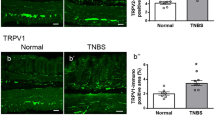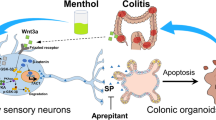Abstract
Background
Transient receptor potential vanilloid type-1 (TRPV1)-expressing sensory neurons release neuropeptides such as substance P (SP) and calcitonin gene-related peptide (CGRP), which play a crucial role in the pathomechanism of experimental colitis. We investigated whether innervation density and neuropeptide release were responsible for the proximodistal aggravation of murine dextran-sulfate-sodium-salt (DSS) colitis.
Methods
Whole mount TRPV1/CGRP immunostained mouse colon preparations were semiquantitatively analyzed. TRPV1 activation by capsaicin and acidic solution (pH 5.1) induced colonic CGRP/SP release, measured by EIA. Single cell quantitative PCR was employed to measure TRPV1 expression levels in DiI-labeled colonic dorsal root ganglion (DRG) neurons. The proximodistal gradient of DSS colitis severity was investigated in WT, CGRP−/−, SP−/−, and resiniferatoxin (RTX)-desensitized mice, employing mouse endoscopy, histology, and body weight measurement.
Results
TRPV1/CGRP-positive nerve fiber density was increased in the distal colon wall. CGRP/SP release induced by TRPV1 activation from the distal colon was greater than that from the proximal colon. This gradient further increased in colitis. TRPV1 gene expression increased in colonic DRGs projecting to the distal, compared to that in colonic DRGs projecting to the proximal colon, and was further enhanced during colitis. In contrast to WT and CGRP−/− mice, SP−/− and RTX-desensitized mice showed amelioration of DSS colitis accompanied by a loss of the proximodistal gradient of inflammation.
Conclusions
The spatial correlation among increased colonic innervation density, TRPV1 receptor expression, stimulated SP release, and colitis severity suggested that TRPV1/SP-expressing sensory neurons should be considered as a therapeutic target in human ulcerative colitis.





Similar content being viewed by others
References
Averbeck B, Reeh PW. Interactions of inflammatory mediators stimulating release of calcitonin gene-related peptide, substance P and prostaglandin E(2) from isolated rat skin. Neuropharmacology. 2001;3:416–23.
Tan LL, Bornstein JC, Anderson CR. Distinct chemical classes of medium-sized transient receptor potential channel vanilloid 1-immunoreactive dorsal root ganglion neurons innervate the adult mouse jejunum and colon. Neuroscience. 2008;156:334–43.
Holzer P. Implications of tachykinins and calcitonin gene-related peptide in inflammatory bowel disease. Digestion. 1998;59:269–83.
Talme T, Liu Z, Sundqvist KG. The neuropeptide calcitonin gene-related peptide (CGRP) stimulates T cell migration into collagen matrices. J Neuroimmunol. 2008;196:60–6.
Levite M. Neurotransmitters activate T-cells and elicit crucial functions via neurotransmitter receptors. Curr Opin Pharmacol. 2008;8:460–71.
Zhao D, Kuhnt-Moore S, Zeng H, et al. Substance P-stimulated interleukin-8 expression in human colonic epithelial cells involves Rho family small GTPases. Biochem J. 2002;368:665–72.
Stucchi AF, Shofer S, Leeman S, et al. NK-1 antagonist reduces colonic inflammation and oxidative stress in dextran sulfate-induced colitis in rats. Am J Physiol Gastrointest Liver Physiol. 2000;279:1298–306.
Reinshagen M, Flämig G, Ernst S, et al. Calcitonin gene-related peptide mediates the protective effect of sensory nerves in a model of colonic injury. J Pharmacol Exp Ther. 1998;286:657–61.
Di Sebastiano P, Grossi L, Di Mola FF, et al. SR140333, a substance P receptor antagonist, influences morphological and motor changes in rat experimental colitis. Dig Dis Sci. 1999;44:439–44.
Fujino K, Takami Y, de la Fuente SG, et al. Inhibition of the vanilloid receptor subtype-1 attenuates TNBS-colitis. J Gastrointest Surg. 2004;8:842–7.
Kimball ES, Wallace NH, Schneider CR, et al. Vanilloid receptor 1 antagonists attenuate disease severity in dextran sulphate sodium-induced colitis in mice. Neurogastroenterol Motil. 2004;16:811–8.
Kihara N, de la Fuente SG, Fujino K, et al. Vanilloid receptor-1 containing primary sensory neurones mediate dextran sulphate sodium induced colitis in rats. Gut. 2003;52:713–9.
Takami Y, Mantyh CR, Pappas TN, et al. Extrinsic surgical denervation ameliorates TNBS-induced colitis in rats. Hepatogastroenterology. 2009;56:682–6.
Wirtz S, Neufert C, Weigmann B, et al. Chemically induced mouse models of intestinal inflammation. Nat Protoc. 2007;2:541–6.
Okayasu I, Hatakeyama S, Yamada M, et al. A novel method in the induction of reliable experimental acute and chronic ulcerative colitis in mice. Gastroenterology. 1990;98:694–702.
Azuma YT, Hagi K, Shintani N, et al. PACAP provides colonic protection against dextran sodium sulfate induced colitis. J Cell Physiol. 2008;216:111–9.
Kitajima S, Morimoto M, Sagara E, et al. Dextran sodium sulfate-induced colitis in germ-free IQI/Jic mice. Exp Anim. 2001;50:387–95.
Nikolaus S, Schreiber S. Diagnostics of inflammatory bowel disease. Gastroenterology. 2007;133:1670–89.
Matsumoto K, Kurosawa E, Terui H, et al. Localization of TRPV1 and contractile effect of capsaicin in mouse large intestine: high abundance and sensitivity in rectum and distal colon. Am J Physiol Gastrointest Liver Physiol. 2009;297:348–60.
Davis JB, Gray J, Gunthorpe MJ, et al. Vanilloid receptor-1 is essential for inflammatory thermal hyperalgesia. Nature. 2000;405:183–7.
Yang J, Li Y, Zuo X, et al. Transient receptor potential ankyrin-1 participates in visceral hyperalgesia following experimental colitis. Neurosci Lett. 2008;440:237–41.
Ferreira J, da Silva GL, Calixto JB. Contribution of vanilloid receptors to the overt nociception induced by B2 kinin receptor activation in mice. Br J Pharmacol. 2004;141:787–94.
Kichko TI, Reeh PW. TRPV1 controls acid- and heat-induced calcitonin gene-related peptide release and sensitization by bradykinin in the isolated mouse trachea. Eur J Neurosci. 2009;29:1896–904.
Zimmer A, Zimmer AM, Hohmann AG, et al. Increased mortality, hypoactivity, and hypoalgesia in cannabinoid CB1 receptor knockout mice. Proc Natl Acad Sci USA. 1999;96:5780–5.
Roza C, Reeh PW, Substance P. Calcitonin gene related peptide and PGE2 co-released from the mouse colon: a new model to study nociceptive and inflammatory responses in viscera, in vitro. Pain. 2001;93:213–9.
Bretag AH. Synthetic interstitial fluid for isolated mammalian tissue. Life Sci. 1969;8:319–29.
Schwartz ES, Christianson JA, Chen X, et al. Synergistic role of TRPV1 and TRPA1 in pancreatic pain and inflammation. Gastroenterology. 2011;140:1283–91.
Schmittgen TD, Livak KJ. Analyzing real-time PCR data by the comparative C(T) method. Nat Protoc. 2008;3:1101–8.
Becker C, Fantini MC, Neurath MF. High resolution colonoscopy in live mice. Nat Protoc. 2006;1:2900–4.
Engel MA, Kellermann CA, Rau T, et al. Ulcerative colitis in AKR mice is attenuated by intraperitoneally administered anandamide. J Physiol Pharmacol. 2008;59:673–89.
Szállási Á, Joó F, Blumberg PM. Duration of desensitization and ultrastructural changes in dorsal root ganglia in rats treated with resiniferatoxin, an ultrapotent capsaicin analog. Brain Res. 1989;503:68–72.
Fischer MJ, Reeh PW, Sauer SK. Proton-induced calcitonin gene-related peptide release from rat sciatic nerve axons, in vitro, involving TRPV1. Eur J Neurosci. 2003;18:803–10.
Strecker T, Messlinger K, Weyand M, et al. Role of different proton-sensitive channels in releasing calcitonin gene-related peptide from isolated hearts of mutant mice. Cardiovasc Res. 2005;65:405–10.
Reinshagen M, Patel A, Sottili M, et al. Protective function of extrinsic sensory neurons in acute rabbit experimental colitis. Gastroenterology. 1994;106:1208–14.
Reinshagen M, Patel A, Sottili M, et al. Action of sensory neurons in an experimental at colitis model of injury and repair. Am J Physiol. 1996;270:79–86.
Mazelin L, Theodorou V, More J, et al. Comparative effects of nonpeptide tachykinin receptor antagonists on experimental gut inflammation in rats and guinea-pigs. Life Sci. 1998;63:293–304.
Evangelista S, Maggi M, Renzetti AR. Down-regulation of substance P receptors during colitis induced by trinitrobenzene sulfonic acid in rats. Neuropeptides. 1996;30:425–8.
Reinshagen M, Flämig G, Ernst S, et al. Calcitonin gene-related peptide mediates the protective effect of sensory nerves in a model of colonic injury. J Pharmacol Exp Ther. 1998;286:657–61.
Derocq JM, Segui M, Blazy C, et al. Effect of substance P on cytokine production by human astrocytic cells and blood mononuclear cells: characterization of novel tachykinin receptor antagonists. FEBS Lett. 1996;399:321–5.
Fiebich BL, Schleicher S, Butcher RD, et al. The neuropeptide substance P activates p38 mitogen-activated protein kinase resulting in IL-6 expression independently from NF-kappa B. J Immunol. 2000;165:5606–11.
Castagliuolo I, Keates AC, Qiu B, et al. Increased substance P responses in dorsal root ganglia and intestinal macrophages during Clostridium difficile toxin A enteritis in rats. Proc Natl Acad Sci USA. 1997;94:4788–93.
Koon HW, Zhao D, Zhan Y, et al. Substance P-stimulated interleukin-8 expression in human colonic epithelial cells involves protein kinase Cdelta activation. J Pharmacol Exp Ther. 2005;314:1393–400.
Koon HW, Zhao D, Zhan Y, et al. Substance P stimulates cyclooxygenase-2 and prostaglandin E2 expression through JAK-STAT activation in human colonic epithelial cells. J Immunol. 2006;176:5050–9.
Mazelin L, Theodorou V, Fioramonti J, et al. Vagally dependent protective action of calcitonin gene-related peptide on colitis. Peptides. 1999;20:1367–74.
Szitter I, Pozsgai G, Sandor K, et al. The role of transient receptor potential vanilloid 1 (TRPV1) receptors in dextran sulfate-induced colitis in mice. J Mol Neurosci. 2010;42:80–8.
Holzer P. TRPV1 and the gut: from a tasty receptor for a painful vanilloid to a key player in hyperalgesia. Eur J Pharmacol. 2004;500:231–41.
Acknowledgments
We thank I. Izydorczyk, A. Kuhn and S. Haux-Oertel for technical assistance, J. Schramm and R. Fischer for excellent maintenance of animal breeding and D. Metzner for graphical assistance (Institute of Physiology and Pathophysiology). Thank you to S. Groß for help with single cell PCR measurements. Thanks also to A. Hecht, K. Loeschner and H. Symowski for preparing the histological slides (Institute of Anatomy I). P.W.R. and M.A.E. were supported by the Federal Ministry of Education and Research (BMBF0315449C); M.A.E. received additional support from the Johannes und Frieda Marohn-Stiftung of the Friedrich-Alexander-Universität Erlangen-Nürnberg. The mouse endoscope was funded by Universitätsbund Erlangen-Nürnberg e.V.
Conflict of interest
None.
Author information
Authors and Affiliations
Corresponding author
Rights and permissions
About this article
Cite this article
Engel, M.A., Khalil, M., Mueller-Tribbensee, S.M. et al. The proximodistal aggravation of colitis depends on substance P released from TRPV1-expressing sensory neurons. J Gastroenterol 47, 256–265 (2012). https://doi.org/10.1007/s00535-011-0495-6
Received:
Accepted:
Published:
Issue Date:
DOI: https://doi.org/10.1007/s00535-011-0495-6




